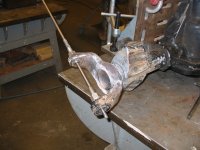Good ideas to try, thanks!
I’ve tried the “bounce the front end and watch the wheel” test and didn’t see any movement. Do folks think that is a solid check for bad drag bar / track bar geometry?
Besides drag bar / track bar geometey, are there other bump steer contributors?
the best way to check for track bar geometry on a Bronco is to just look at it. The links are close enough to each other that you can see the "parallelogram" by eye.
Bouncing to test for bump steer is kind of useless. You need to remove the shocks in order to cycle the suspension enough to exaggerate the motion to actually see any bump steer deflection. By then, the axle is shifting laterally more than the bump steer is inducing steering, and you can't see anything.
If you launch your Bronco in the big moguls on the trail, you can get big suspension movement to get maximum bump steer. On a properly aligned front axle, the bump input is predictable, and mildly annoying. I've seen up to 1/4 turn of steering input needed to compensate. But you can still maintain perfect control at speed. Bump steer does not "cause" darty steering. Bump steer will induce darty steering, but if you have darty steering, you will get it by simple lane corrections, road imperfections, directional changes, cross-wind, AND bumps.
@Yeller is giving some great advice regarding rear axle dynamics. A Bronco with loose rear u-bolts will have all sorts of wierd and ugly steering effects...including dartyness.
I'm using dartyness as a word to describe what some will call wandering, or lack of centering force, or vagueness. Happens at highway speeds, usually when trying to make a lane change. Old timers would say that it "won't hold the road." I have to be careful here, because people that build race cars have very different expectations for very similar effects...and we all use the same words. As soon as you start to approach the limits of adhesion or tire sidewall rigidity...the vehicle dynamics mean different things. Slip angle, contact patch, tread deformation, load vs grip, ackerman, camber, lateral acceleration, turn-in, understeer, oversteer, snap-throttle, suspension loading, and unloading, anti-ackerman, and a whole bunch of suspension, tuning, and valving come into play. And it's important, and it's a science unto itself. So I don't want to hurt anyone's feelings by saying it's crap. But for the purpose of getting a Bronco to make a modest lane change down the freeway at 60 MPH...it's not applicable.
So you can chase bump steer if you like. It's not a horrid endeavor. But you'll still want to cure your darty steering. So let's get back to some basics. Shock valving is also a science. I am always baffled by the general assumption that high value shocks are somehow better. They most certainly can be better, but they can also be worse. I don't like under-damped front suspension on a Bronco. I don't even like gas charged Bilsteins. Bone jarring RS5000's, or RS9000's set to max seem to do a good job. The 70/30's from Duff are aslo pretty stiff, but you want at least 2 per corner. Rock crawler springs, and super flexy suspension didn't do anyone any favors. So if your Bronco "wallows" or "sways" or is generally "vague" and "listless" then your dampening needs attention. I prefer to start with over-damped, stiff suspension, and minimal deflection under load...which is the exact opposite of "flexy rock crawler." I'm convinced that any Bronco with a 3 inch rock crawler lift will need a front sway bar. Not because it is darty, but because it wallows and feels like you are sitting on top of an exercise ball.
Hope that helps.













